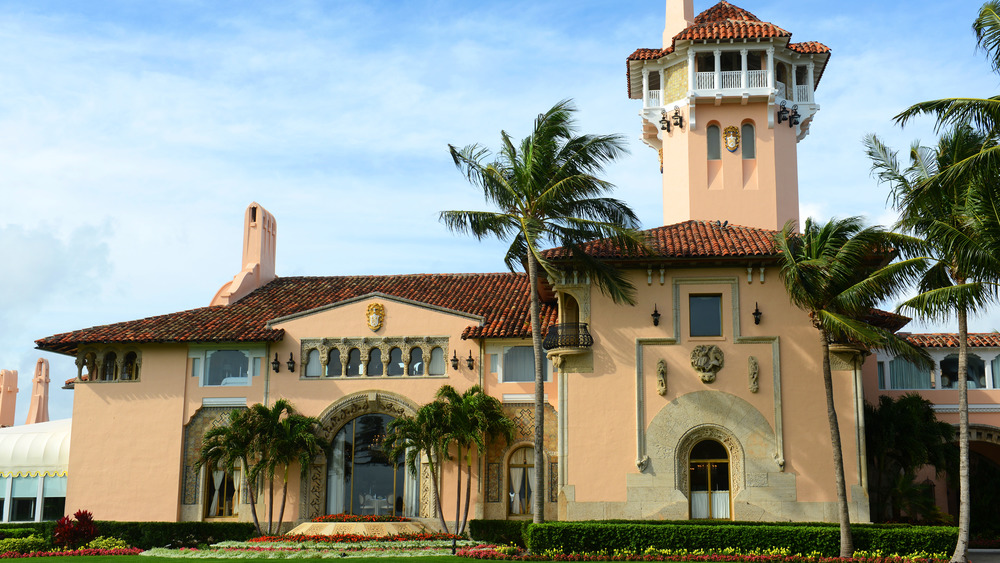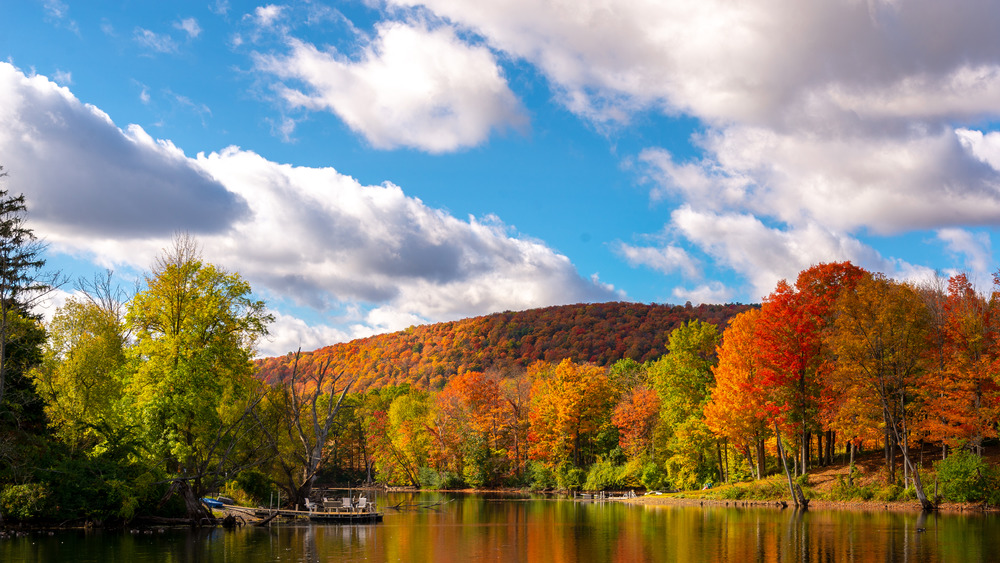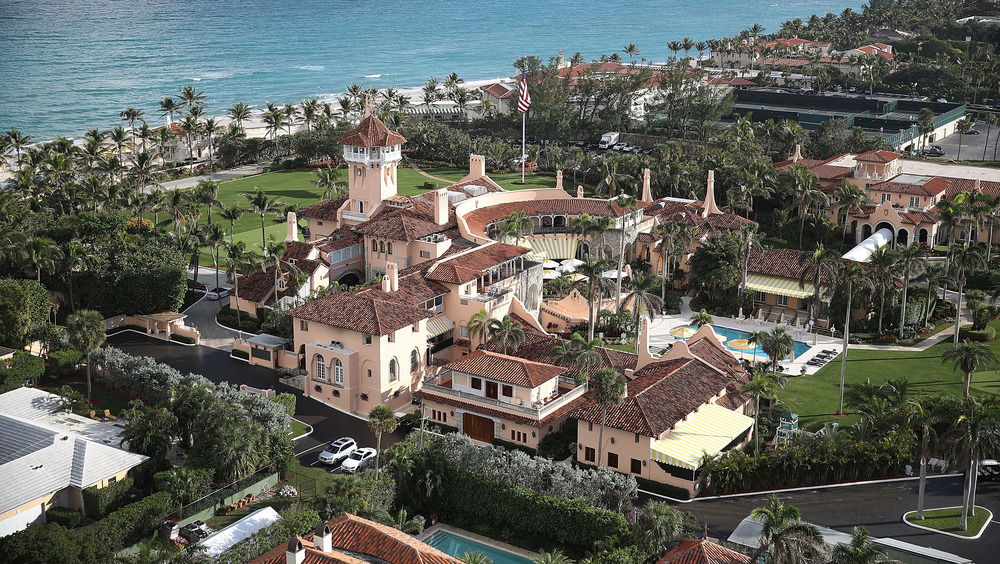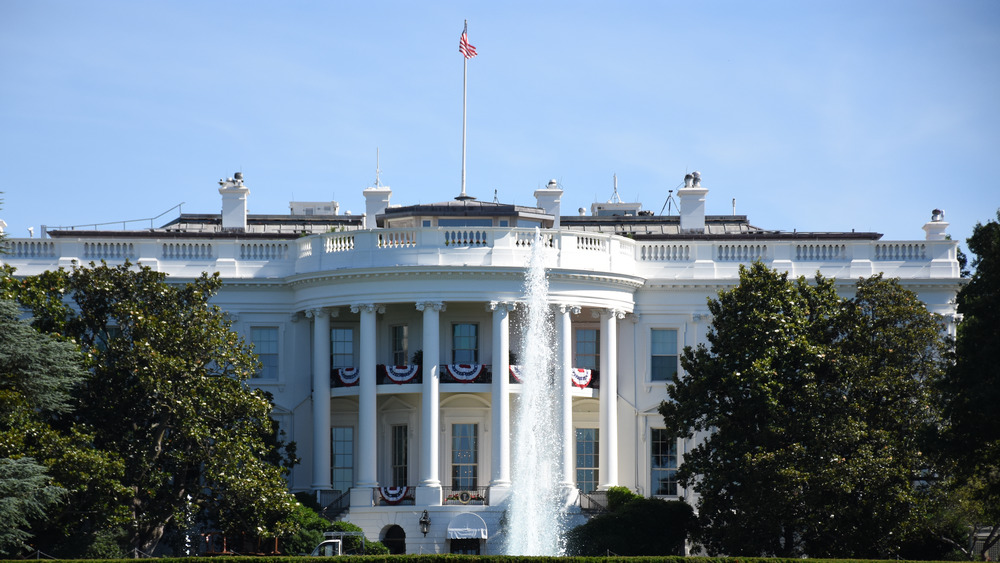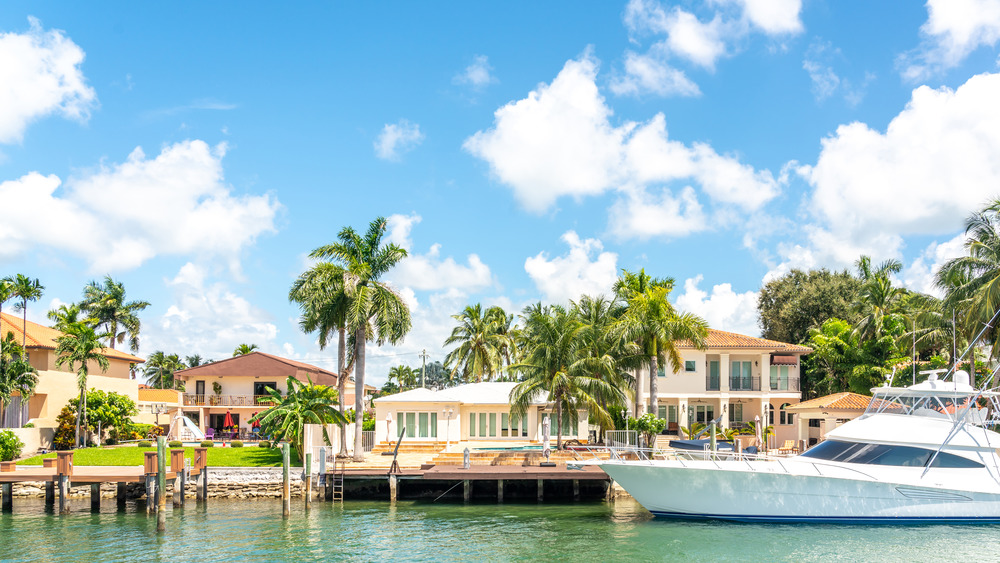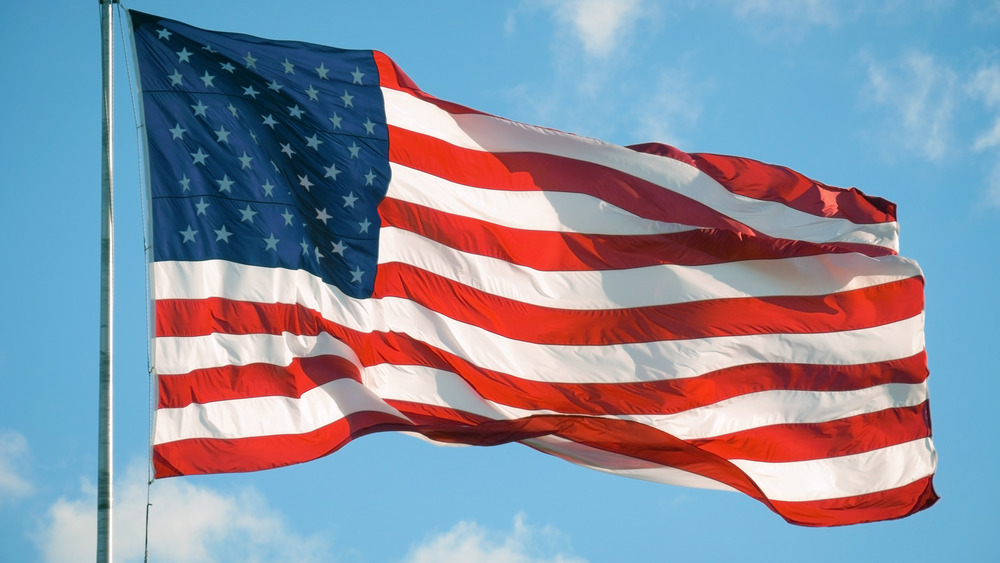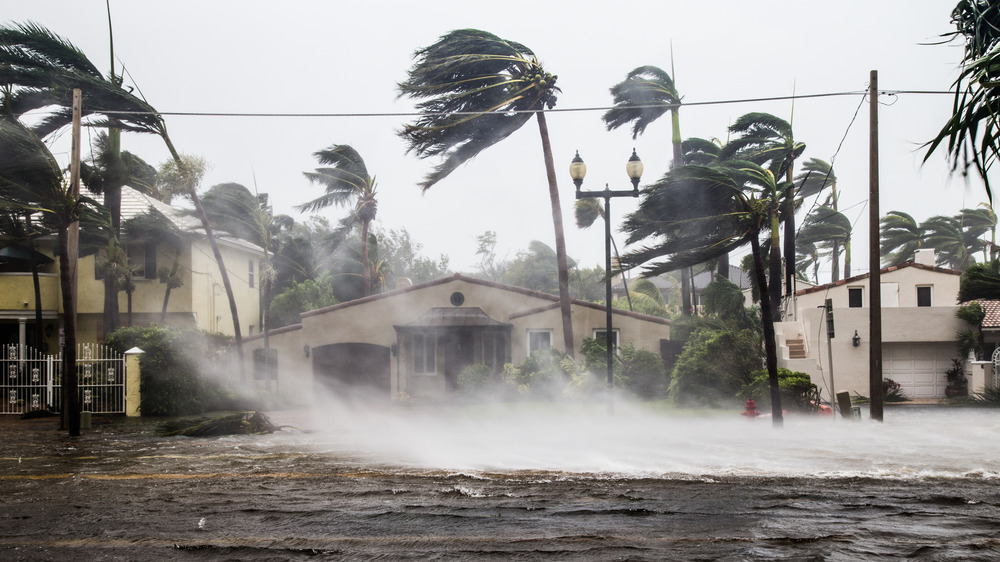The Untold Truth Of Mar-A-Lago
What do you think of when you think about Mar-a-Lago?
You might think about golfing — but the exclusive vacation resort for the ultra-wealthy actually isn't a golf course. While it has a relationship with the Trump International Golf Club, it's effectively little more than an extraordinarily luxurious hotel. So what really happens at Mar-a-Lago?
Mar-a-Lago is President Donald Trump's primary residence, a resort club for the extremely wealthy, and an estate with more history than you might expect. Its name means "sea to lake" in Spanish, owing to its location between the Atlantic ocean and Lake Worth in Palm Beach, Florida — and it's spent its time as everything from an occupational therapy center to a protected historic site.
While the list of members is secret, known members include the likes of Bill Koch (of the notorious Koch brothers), James Patterson (fiction author), Bill Belichick (coach of the New England Patriots), and Janet Weiner (part-owner of Rockstar Energy Drink). And because of its high-profile owner, Mar-a-Lago has been consistently hitting the headlines for the last four years (such as when it charged taxpayers $3 for a glass of water).
But that's just what's been in the news. There's more to Mar-a-Lago's history than just the last four years.
Mar-a-Lago was built by the heiress to the Post fortune
Marjorie Merriweather Post was the first owner of Mar-a-Lago, per Town and Country. Mar-a-Lago was designed to have 58 bedrooms and 33 bathrooms, at the cost of $7 million — double its initial price tag. In 2020, the same property would cost $104,753,793 to build. But Marjorie Post wasn't deterred by the heavy price. She had more than enough money.
Today, Marjorie Post isn't a household name. But in 1927, she was. Marjorie Post was heir to Postum Cereal Company, inheriting it when she was just 27 years old. By all accounts, she was a savvy businesswoman, but she liked to spend her money as much as make it. She would eventually own one of the world's largest sailing yachts, a triplex penthouse in New York, and an extensive art collection.
Postum Cereal Company, of course, would eventually become Post Consumer Brands. Marjorie Post was both a socialite and a philanthropist, not only creating a multitude of networking opportunities among the rich and elite but also working on charitable contributions later in life, particularly to do with World War II, when she opened the estate to veterans in need of occupational therapy, according to Smithsonian Magazine. It only makes sense that Mar-a-Lago — now known for its high society members — would become a part of her legacy.
Mar-a-Lago was only one of nearly a dozen estates owned by Post
Marjorie Post's entire real estate portfolio, including Mar-a-Lago, would be estimated to be worth $1 billion today. Three of those properties were used to socialize with other millionaires and billionaires. Almost all of them would prove difficult to unload once she passed. She was a woman addicted to architecture.
In Greenwich, Connecticut, Post owned an 11-bedroom fieldstone mansion, known as the Boulders. She also owned the August S. Houghton Home in the same town, a home built in 1908 and presently worth $2.9 million.
In New York, she created a triplex penthouse that had 54 rooms. This would be later re-divided so that it could be leased out, showing that she had a penchant for properties that would become a liability to its owners later.
In Palm Seaside, Florida, she constructed a 10,000 square foot mansion known as Hogarcito as a winter retreat. Just a few years later, she would construct Mar-a-Lago with the help of the same architect: Marion Sims Wyeth. It would appear that she wanted Hogarcito, but done even better.
In addition to the above, she had Camp Topridge in the Adirondacks, Tregaron in Washington D.C., and finally, Hillwood in Washington — a 25,000 square foot neo-Georgian mansion. Anywhere Post went, she was home.
Mar-a-Lago's budget caused problems in Post's marriage
In a letter, Marjorie Post complained that the costs of building Mar-a-Lago continued to rise and that her husband (E.F. "Ned" Hutton) was less than pleased. It's not surprising. She had just finished building a 10,000 square foot home before she started the project, after all. In the letter, she mentioned having to sell some of her Postum stock to cover the costs — stock that would have undoubtedly continued rising, given the history of the cereal company. Part of this had to do with the complex architecture she desired.
Marjorie Post was known for uncompromising standards, stating, "There are others better off than I am. The only difference is I do more with mine. I put it to work," (via AJC). These desires led to the building of Mar-a-Lago snowballing, so insistent was she on achieving her vision for the property.
When completed, Mar-a-Lago was a full 17-acre estate, with an 11,000 square foot house, 58 bedrooms, and 33 bathrooms. Inspired by palaces in Europe, and Spanish-Moorish architecture, it was all built to discriminating specification. Sometimes referred to as America's Xanadu, it's known for being incredibly ostentatious — and, to many, to the extent that it crosses the line into poor taste.
In 1944, Mar-a-Lago was opened up to WWII veterans
Mar-a-Lago wasn't always a retreat for the wealthy and politically powerful.
In the 1940s, shacks were erected throughout Mar-a-Lago for the support of returning veterans. Workshops for leather, sculpting, furniture repair, printing, and carpentry were all created to ease the transition, the Palm Beach Daily News explains. Later, Mar-a-Lago would become the host to the Red Cross Ball, showing Marjorie Post's continued interest in charitable acts.
Mental health treatment became critical following World War II, with many experiencing what was then known as war trauma or combat exhaustion. Occupational therapy centers kept veterans active and stimulated, by giving them tasks to do as they recovered. Everyday activities can help give individuals structure and a sense of normalcy, which they would certainly have been lacking during war-time events.
The veterans themselves were not housed at Mar-a-Lago but rather at The Breakers, operating as the Ream General Hospital. Nevertheless, opening up her home to veterans to convalesce is one of Post's lasting legacies.
Mar-a-Lago was unsuccessfully donated to the federal government
Marjorie Merriweather Post had always wanted Mar-a-Lago to be useful following her death in 1973. Her initial idea had been to give it to the state of Florida, but it declined. The Post Foundation then tried to give it to the federal government. President Richard Nixon even scoped out the property in 1974, per the New York Times, but the federal government ultimately declined the property in 1981. Both of them likely declined because the costs of maintenance would simply have been too high. Much like her penthouse would eventually need to be subdivided, Mar-a-Lago really wasn't useful to anyone in its current state.
From the government's perspective, this was absolutely the right move. The annual costs of maintaining the estate would have been $1 million. While Mar-a-Lago could have been a "more luxurious Camp David," the truth of the matter was that it required a staff of over 20 year-round gardeners alone, according to Town and Country. Ultimately, issues of cost and zoning were too difficult to surmount.
Ironically, Mar-a-Lago was presented to the federal government as a "winter White House" — something that it would, in fact, eventually become. A white elephant gift, it was eventually put up for sale on the private market for $20 million.
Mar-a-Lago was designated as a national historic landmark
In 1969, Mar-a-Lago was established as a national historic site and briefly turned over to the National Park Service. In 1972, it was placed on the National Register of Historic Places. But in 1980, it was returned by Congress to the Post Foundation. Once again, it was found to be a little too expensive for anyone, including the National Park Service, to maintain.
Mar-a-Lago has remained a National Historic Landmark in name and is one of 2,500 such landmarks in the United States, according to LiveAbout. Both the location's architecture and its history were cited as reasons for landmark status, and being turned over to the National Park Service was one of the last moves to try to save the property from private sale. The architecture of the property had influences from Spain, Venice, and Portugal, and the natural beauty of the site (and its history) more than qualified it at the time.
Of course, others still consider it a tremendous eyesore. It's not a surprise that President Jimmy Carter, the only ex-president to recently fly by commercial airline, turned up his nose at the ostentatious, multi-million dollar estate, per TC Palm.
Trump paid around $10 million for Mar-a-Lago
So, everyone had turned down Mar-a-Lago. The state government, the federal government, and even the National Park Service. All that was left is to put it up for private sale. Ironically, this was probably because the Post Foundation, too, found it too expensive to continue to maintain.
Donald Trump bought Mar-a-Lago in 1985 for $10 million, far under the $20 million asking price for the property. As Forbes reported, the $10 million for Mar-a-Lago parceled out to $5 million for the house, $3 million for furnishings, and $2 million for beachfront property across the street. Rumor had it that Trump had threatened to block Mar-a-Lago's beach view after purchasing property between it and the beach, according to USA Today 10Best. It's proven that he bought that property, and though the threats are unverified, with this tactic, the purchase would have plummeted the property's value.
Regardless, the $10 million purchase reportedly made Trump about $22 million in revenue in 2018, yielding some substantial returns — and that's one of its worse off years. Trump has also come under fire in the press for allegedly benefiting financially from the presidency, with the acknowledgment that anytime President Trump visits Mar-a-Lago, the "revenue to Trump from taxpayers from those kind of visits can be in the tens of thousands of dollars," per NPR.
There have been three high-profile lawsuits at Mar-a-Lago
Well, there have certainly been more than three high-profile lawsuits involving the Mar-a-Lago property. But there were three long-term, high-profile lawsuits that were publicly fought by Mar-a-Lago.
The first such lawsuit was litigation over an illegal, 80-foot flag. Donald Trump had the flag installed without a permit in the 1980s, and both its size and location violated local ordinances. In 2006, as Jacksonville.com reports, Trump sued the town for $10 million for their demands to remove the flag, eventually increasing this to $25 million in damages. So, in 2007, the town fined Trump $1,250 a day. Ultimately a settlement was reached; Trump moved the flag and contributed $100,000 to charities, most of the amount given to veteran-related causes.
The second lawsuit is a little more complex. In 1996, when Trump attempted to increase the capacity of Mar-a-Lago, he was unable to do so because of noise and traffic restrictions. He sued the town of Palm Beach, on the basis that he was being discriminated against for running a non-segregated club — a club which included Black and Jewish members, the Washington Post explains. It was true that Mar-a-Lago was the first non-segregated club in the region, though it was never proven that the city council was targeting Mar-a-Lago for that reason.
Finally, in 2015, there was a $100 million lawsuit that Trump filed over the fact that planes kept disrupting the airspace over Mar-a-Lago. But this lawsuit was voluntarily dismissed.
Michael Jackson and Lisa Marie Presley honeymooned at Mar-a-Lago
In 1994, Michael Jackson and Lisa Marie Presley spent their honeymoon in Mar-a-Lago. But while Michael Jackson may have arguably been the most famous guest, there were many celebrities who visited, even if they may not have maintained $100,000 memberships.
Other surprising celebrities seen at Mar-a-Lago included: Elton John, William Shatner, Rod Stewart, James Taylor, and Woody Allen. Notably, those who attend Mar-a-Lago's festivities don't seem to have very much in common, ranging in industry and politics. With Mar-a-Lago having a nearly hundred-year reputation for socializing and network-building, it's understandable why that might be.
Interestingly, one person not welcome at Mar-a-Lago was the infamous Jeffrey Epstein. In The Grifter's Club: Trump, Mar-a-Lago, and the Selling of the Presidency, it's alleged that he was a member for some years, but was ultimately banned by Trump for hitting on the teenage daughter of a guest (via CNBC). Mar-a-Lago had initially denied the claims that he was a member.
Mar-a-Lago has been hit with 78 health and safety violations
It costs $2,000 to dine at Mar-a-Lago a year, but members might not want to; the kitchens have received nearly 80 health and safety violations within just a few years. These included foods held at inappropriate temperatures, food well past its expiration, and mold in the ice machine.
To put this into perspective, food and safety inspectors find on average 2.4 violations during an inspection. Every year, some 3,000 Americans die of food-borne illness and 128,000 are hospitalized, making these health inspections particularly important.
Safety violations uncovered at Mar-a-Lago were similarly alarming. There were slabs of missing concrete and a lack of smoke detectors for the hearing impaired, both of which could combine into a uniquely dangerous situation. In an estate that makes millions per month, these are pretty dramatic oversights.
Of course, there's a reason why Mar-a-Lago is still open; it eventually did pass its health and safety inspections. And, interestingly, in 2015, it had only experienced two violations, while in 2016 there were 11 — signs that the resort had been slipping well before the presidency, per CheatSheet.
Today, it costs $200,000 to join Mar-a-Lago
Mar-a-Lago requires an initiation fee to be a member. While it was $100,000 for some time, it was brought up to $200,000 in 2017. Few are aware of exactly what perks this membership entails; the information, and the member list, is exclusive.
Membership requests were much higher after Trump became president and the initiation fee was increased to $200,000 at that time — part of what many argue is an oversight, as the president is not intended to financially benefit from the office. The resort, on the other hand, stated that it had been considering the increase for some time.
In addition to the $200,000 that members pay (plus tax), members also pay $14,000 in annual dues. So, it isn't just a one-time fee, but also a recurring charge.
Since Mar-a-Lago doesn't have its own golf course, what's included? There are privileges at Trump's own golf courses, access to two pools, tennis courts, a croquet court, a Beach Club, a discount on guest suites, the main house, and the dining area. If that sounds like not enough, you're probably right; the truth is that the fees probably cover the networking opportunities and prestige.
Mar-a-Lago could be claimed by rising sea levels
Quite a few speculate that Mar-a-Lago could be underwater by 2100, with simulations by the National and Oceanic Atmospheric Administration depicting it being 10 feet underwater. Findings indicate that South Florida sea levels could rise by 3 feet by 2050 or 7 feet by 2100, both of which could cause significant damage. That's not too far off — it could begin taking a dramatic toll only 30 years from now. (It's perhaps somewhat ironic that Mar-a-Lago features artwork inspired by Venice.)
South Florida has already been experiencing some significant damage due to flooding, and, in 2017, environmental experts testified at a hearing on climate change that Trump's resorts could eventually be damaged by the phenomenon. They did so upon an observation — that Trump was generally more willing to react to environmental concerns if they directly impacted him and his investments.
They didn't succeed. But, with a 400 percent increase in high-tide flooding in South Florida from 2006 through 2016, it's likely that it's only a matter of time. If nothing else, it will be an interesting end to a legacy that was first begun by a socialite searching to build the perfect home.
